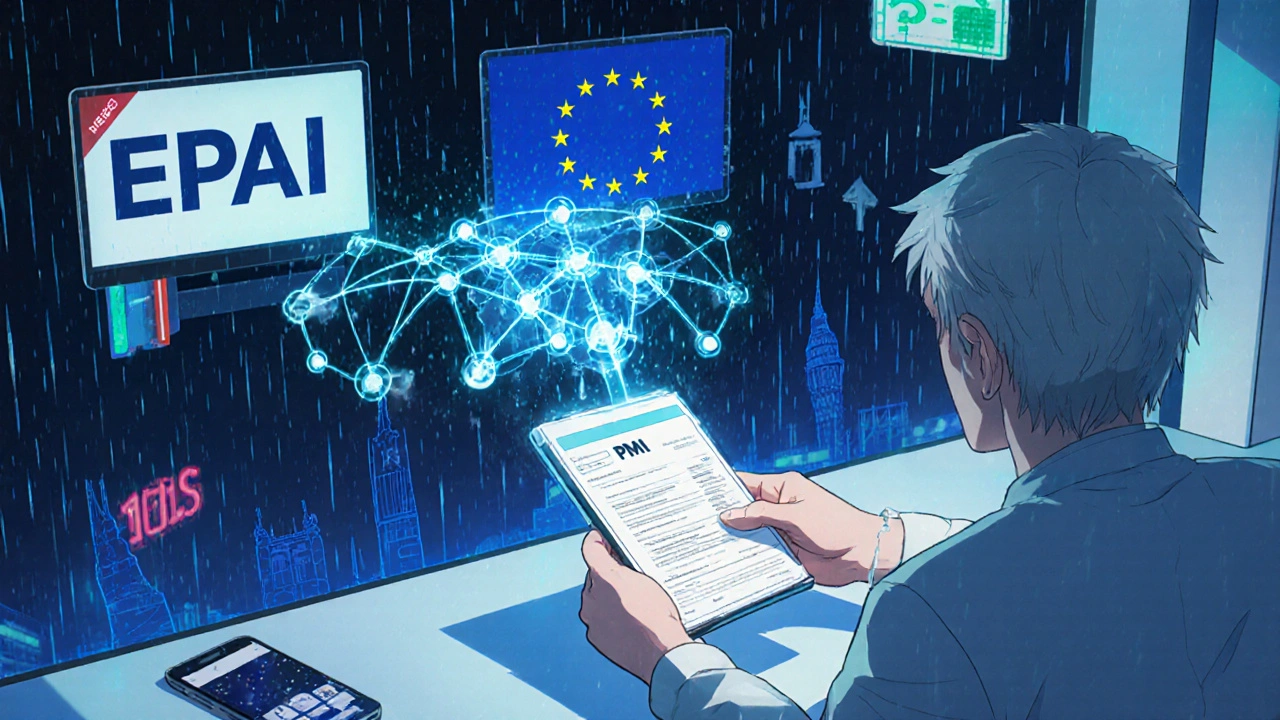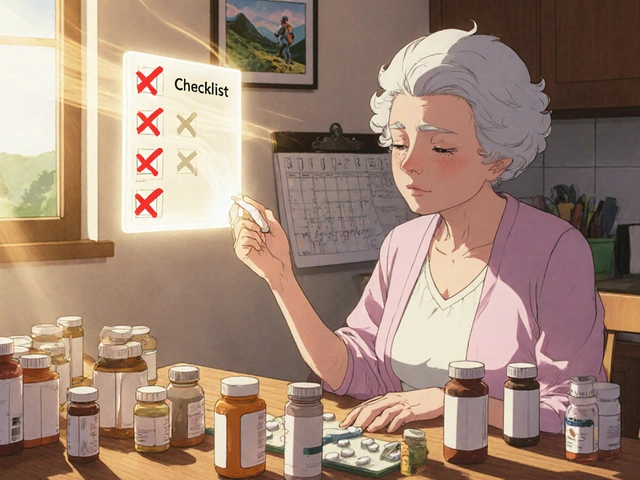PMI Information Preview Tool
Preview Your Medication Information
See how the FDA's new Patient Medication Information (PMI) format would display for your prescription drug. The PMI is a standardized, one-page information sheet designed to be clear, consistent, and easy to understand.
Patient Medication Information
Use exactly as prescribed.
This is the first line of every PMI. It emphasizes the importance of following your doctor's instructions.
Directions for use:
[Directions would appear here]
Special handling:
[Special handling instructions would appear here]
Storage and disposal:
[Storage and disposal instructions would appear here]
Warnings:
[Warnings and precautions would appear here]
Common side effects:
[Common side effects would appear here]
Note: This is a simplified example. Actual PMI will follow FDA requirements. The FDA does not include exact percentages for side effects to avoid overwhelming patients.
The U.S. Food and Drug Administration (FDA) is pushing for a major change in how prescription drugs come with patient instructions. Right now, only about 150 out of thousands of prescription medications include a Medication Guide - and even those vary wildly in format and content. Starting in 2025, that’s about to change. The FDA’s proposed Patient Medication Information (PMI) rule would require every outpatient prescription drug to come with a single-page, standardized information sheet designed to be clear, consistent, and easy to understand.
What Exactly Is the PMI?
The PMI isn’t just another handout. It’s a new federal standard for how patients get instructions about their medicines. Unlike today’s Medication Guides, which are only required for drugs with serious risks (like opioids or blood thinners), the PMI would apply to all outpatient prescriptions - including antibiotics, blood pressure pills, diabetes meds, and even birth control. That’s roughly 6.7 billion prescriptions per year. The format is strict: one page, 12-point font, plain language. No jargon. No marketing. No fluff. It must start with the words: “Use exactly as prescribed.” After that, it covers only what patients need to know to use the drug safely: how to take it, when to take it, how to store it, what to avoid, and the most common side effects. The FDA spent years testing different layouts with real patients. They found that people understood critical safety info 25-40% better with the new PMI format than with current guides - especially those with low health literacy. About 80 million U.S. adults struggle to understand medical instructions, and this change is meant to help them.How Is It Different from Today’s Medication Guides?
Right now, if you pick up a prescription, you might get a guide - or you might not. It depends on the drug, the pharmacy, and sometimes even the pharmacist’s discretion. Some guides are three pages long. Others are two paragraphs. Some list risks. Others skip them entirely. The PMI fixes that. Every drug gets the same structure:- Heading: “Patient Medication Information”
- First line: “Use exactly as prescribed.”
- Directions for use: Dose, frequency, route (oral, injection, etc.)
- Special handling: Refrigeration? Keep away from light?
- Storage and disposal: How to keep it safe at home, how to throw it out properly
- Warnings: Allergies, drug interactions, pregnancy risks
- Common side effects: Only the most frequent ones - not every possible reaction
What’s Missing? Critics Say Patients Need More
Not everyone agrees this is enough. Researchers at the University of Pittsburgh tested a modified version called “Decision Critical PMI.” For a drug like mifepristone, instead of saying “headache is a common side effect,” their version said: “43% of patients experience headache.” Patients told researchers that numbers like that helped them decide if a side effect was normal or something to worry about. One participant said, “If I know 48% get a fever, I know it’s not rare - I should expect it.” The FDA’s version avoids numbers. Why? Because they’re worried about overwhelming patients. They also say precise percentages can be misleading if they’re based on small studies or don’t reflect real-world use. But critics argue that without numbers, patients are left guessing - and guessing can lead to stopping medication unnecessarily.Electronic PMI Is Now an Option
You won’t have to take a paper copy anymore. The FDA now allows electronic PMI - meaning you can get it via email, a pharmacy app, or a patient portal. But there’s a catch: it must be accessible to everyone. That means it has to work with screen readers, be readable on small phones, and be available in multiple languages if the pharmacy serves diverse communities. Pharmacies will still have to offer paper copies on request. No one gets left behind. The goal is choice - not replacement.Who Has to Do What? Implementation Timeline
The rule isn’t final yet. The FDA closed public comments in November 2023 and is reviewing over 1,200 submissions. The final rule is expected in early 2024, with full rollout starting in 2025. Here’s who’s affected:- Drug manufacturers: Must create, submit, and update PMIs for every outpatient drug they make. The FDA will review each one. Large companies get 24 months to comply; smaller ones get 36.
- Pharmacies: Must distribute the PMI with every prescription - paper or digital. This adds 30-60 seconds per prescription during the first year. Staff will need 2-4 hours of training, plus annual refreshers.
- Doctors: Not directly responsible, but they’ll need to be ready to answer questions patients have after reading the PMI.

Why This Matters for You
If you take any prescription - even once a year - this change affects you. Right now, you might get confused by unclear labels. You might skip a dose because you didn’t understand the instructions. You might stop taking your medicine because you didn’t realize a side effect was normal. The PMI is meant to cut through that confusion. It won’t solve every problem - it won’t tell you if the drug will work for you, or how it compares to others. But it will give you a consistent, trustworthy source of safety info you can count on, no matter where you fill your prescription. Studies show patients who get clear instructions are 30% more likely to take their meds correctly. That means fewer hospital visits, fewer bad reactions, and better health outcomes.What Comes Next?
The FDA says this is just the first step. They’ve already heard feedback that patients want more - like benefit information and clearer risk numbers. They’re watching research from the University of Pittsburgh closely. If those studies show better understanding with more detailed PMIs, we could see an update in 2026 or 2027. Meanwhile, the European Medicines Agency is watching. They’re considering something similar for 2025. This isn’t just an American change - it’s becoming a global standard. For now, if you’re on a prescription, keep an eye out for the new label in 2025. It’ll look different. It’ll be shorter. But it’s designed to help you - not overwhelm you.Will every prescription drug have a PMI starting in 2025?
Yes. Starting in 2025, all outpatient prescription drugs - including pills, injections, and blood transfusions given outside hospitals - will come with a standardized Patient Medication Information (PMI) sheet. This includes common medications like antibiotics, blood pressure pills, and birth control. The only exceptions are drugs used exclusively in hospitals or for inpatients.
Can I get the PMI electronically instead of on paper?
Yes. The FDA allows electronic delivery of PMI through pharmacy apps, email, or patient portals. But pharmacies must still offer a paper copy if you ask for one. Electronic versions must meet accessibility standards (Section 508), meaning they work with screen readers, are readable on mobile devices, and are available in multiple languages if needed.
Why doesn’t the PMI include how well the drug works or its benefits?
The FDA says the PMI is focused on safety and proper use - not treatment decisions. Doctors are expected to explain why a drug is prescribed and what benefits to expect. The PMI’s job is to help you take it correctly and avoid harm. Critics argue this leaves patients without key info, and the FDA is monitoring research that may lead to future updates including benefit data.
Will the PMI list exact percentages for side effects?
No. The current version uses terms like “common,” “uncommon,” or “rare” instead of exact numbers. For example, it might say “headache is a common side effect” instead of “43% of patients experience headache.” The FDA believes this avoids confusion and keeps the document simple. However, researchers are testing versions with numbers, and future updates could change this based on patient feedback.
How will pharmacies handle the new PMI?
Pharmacies will need to integrate PMI distribution into their dispensing workflow. This means printing or emailing the PMI with each prescription. The FDA estimates this adds 30-60 seconds per prescription initially. Staff will need 2-4 hours of training, plus one hour of annual refreshers. Pharmacies must also ensure digital PMIs are accessible and offer paper copies on request.
Is the PMI only for U.S. patients?
The rule applies to all prescription drugs dispensed in the U.S. outpatient setting. However, the European Medicines Agency is considering a similar standard for 2025, and other countries are watching closely. This could become a global model for patient medication information.










Comments (12)
David Barry
November 12, 2025 AT 01:59 AMThe FDA's PMI is just bureaucracy in a nice suit. They're not fixing the problem-they're just making the paperwork prettier. Real problem? Doctors don't explain meds. Pharmacies rush you out the door. No amount of standardized text fixes that.
Benjamin Stöffler
November 13, 2025 AT 02:56 AMLet’s be clear: this isn’t about patient safety-it’s about liability minimization. The FDA avoids numbers because numbers create legal exposure. “Common side effect”? That’s legalese disguised as clarity. If 43% of patients get headaches, say it. If 12% get hallucinations, say it. Omitting data isn’t protection-it’s patronizing. And don’t get me started on the “Use exactly as prescribed” opener-like we didn’t already know that. This is performative simplicity.
Mark Rutkowski
November 13, 2025 AT 19:45 PMI actually think this is a quiet revolution. For years, I’ve watched my grandma squint at her pill bottles, confused by three-page guides full of Latin terms and tiny fonts. She’s not dumb-she’s just been failed by the system. This PMI? It’s the first time the system tried to meet her where she is. No fluff. No marketing. Just: here’s how to stay safe. That’s dignity. And honestly? If this works, it could change how the world thinks about patient communication. The Europeans are watching for a reason.
Ryan Everhart
November 15, 2025 AT 18:45 PMSo… you’re telling me the government is now responsible for making sure I don’t accidentally take my blood pressure pill with grapefruit juice? Cool. I’m sure that’ll stop the 80 million people who still think ‘as needed’ means ‘whenever I feel like it.’ Honestly, I’m just impressed they didn’t include a QR code that plays a 30-second TikTok from a pharmacist named Dave.
Alyssa Lopez
November 16, 2025 AT 16:41 PMThis is why America is falling behind. We’re giving out pamphlets instead of demanding accountability. If you can’t handle a little jargon, maybe you shouldn’t be on 7 different prescriptions. The real issue? People don’t listen to doctors. Not the label. Not the guide. THEM. This is just another taxpayer-funded distraction.
Alex Ramos
November 18, 2025 AT 11:00 AMAs a pharmacist, I’ve seen this change up close. The training was rough, but the feedback? Gold. Patients are asking better questions now. They’re saying, ‘Wait, this says headache is common-so I’m not crazy?’ Yes. You’re not. And now we can actually talk about it. 🙌 This isn’t perfect, but it’s the first step that actually puts the patient in the center. Keep going, FDA.
edgar popa
November 19, 2025 AT 20:05 PMFinally something simple. I hate reading those long guides. Just tell me when to take it and what not to eat. Done.
Eve Miller
November 21, 2025 AT 05:17 AMThere is no excuse for the FDA’s refusal to include statistically significant side effect data. The omission is not merely negligent-it is ethically indefensible. To claim that patients cannot comprehend percentages is to infantilize an entire demographic. The term 'common' is vague, unquantifiable, and thus unscientific. This is not patient-centered care; it is paternalistic obfuscation.
Chrisna Bronkhorst
November 22, 2025 AT 12:19 PMLet’s not pretend this is about patients. It’s about cost control. Pharmacies are getting slammed with new workflows, manufacturers are paying billions, and who benefits? Insurance companies. Fewer ER visits means fewer claims. This isn’t healthcare reform-it’s financial engineering disguised as compassion.
Amie Wilde
November 23, 2025 AT 06:41 AMMy aunt took her pills wrong for years because the label said 'take with food' but she thought 'food' meant a snack. Now she’ll know it means a full meal. Small thing. Big difference.
Gary Hattis
November 24, 2025 AT 13:40 PMAs someone who grew up in a household where English wasn’t the first language, I’ve seen how confusing these labels can be. The multilingual digital PMI? That’s huge. My mom finally understood why she couldn’t drink grapefruit juice with her statin. Not because someone yelled at her. Because the app told her-in Spanish-with a picture of a grapefruit crossed out. That’s equity.
Esperanza Decor
November 24, 2025 AT 21:31 PMI’ve been on 12 different meds over the last 5 years. Half the time I didn’t know what the side effects were because the sheets were either missing or written like a legal contract. This PMI? It’s the first time I felt like the system actually wanted me to survive. I’m not saying it’s perfect-but for once, I didn’t feel like a burden for asking questions. And that matters more than you think.